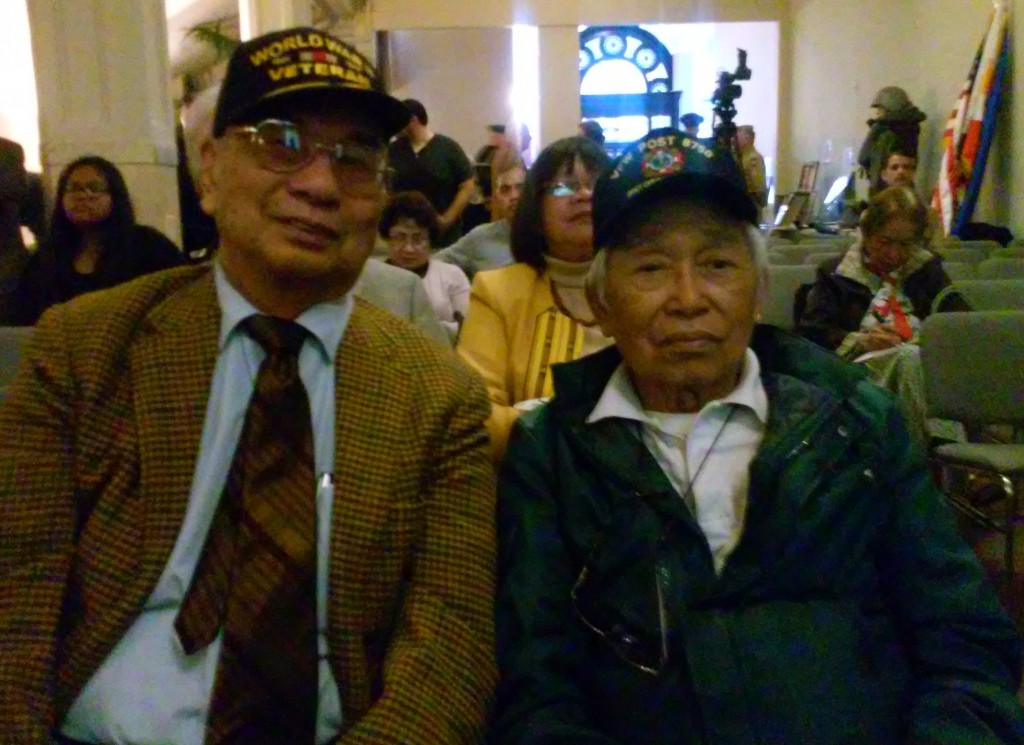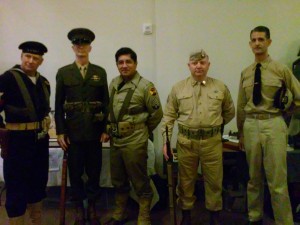Online petition–include Filipino veterans’ WWII role in Calif. curriculum

WWII veterans David Tejada and Pedro Pineda at the Leyte landing commemoration at the Philippine Center in San Francisco last October. PHOTO BY JUN NUCUM
SAN FRANCISCO — An online petition campaign is trying to ensure the implementation of a law passed in October requiring the inclusion of the contributions of Filipino soldiers to the Allied victory in World War II.
The Bataan Legacy Historical Society (BLHS) is urging the implementation of AB199 or the World War II (WWII) Filipino Veterans in Curriculum Act, adopted by the California legislature in September 2011 and approved by Governor Jerry Brown last October.
Cecile Gaerlan, BLHS executive director, whose father was with the 41st Infantry Regiment, said her organization resorted to the online petition at change.org starting last November 3, the proposed curriculum framework of the History-Social Science Content Standards for California Public Schools adopted by the State Board of Education failed to mention Bataan, the Filipinos and their role during WWII and even WWII in the Philippines itself.
“We are petitioning the Instructional Quality Commission and the Curriculum Frameworks and Instructional Resources Division to implement this legislation and to make necessary revisions to Section 51221.3 of the Educational Code to include the Bataan Death March and WWII in the Philippines where thousands of Filipino and American soldiers died and a million civilians perished,” explained Gaerlan. The petition so far has only 10 percent of its targeted 5,000 signatures.
Barely mentioned
Ironically, the Filipino-Americans in California comprise one of the largest ethnic groups in the state, second only to the Chinese-Americans, but the curriculum barely mentions the contributions of the Filipinos and the Filipino-Americans before, during and after World War II.
Sponsored by Assemblymembers Fiona Ma (D-San Francisco and San Mateo Counties) and Paul Cook (Assemblyman Paul Cook R-Yucca Valley), the law, said Ma, seeks to “encourage social science instruction in grades 7-12 to include the significant role of Filipinos in World War II,” which “helps ensure that our children and future generations learn.”
The field review for the state curriculum for Grades 7-12 will end on November 25 and is done with revision every ten years While State Superintendent Tom Torlakson says that he supports AB199, the current social sciences curriculum under review does not include AB 199 or WWII in the Philippines.
“We have to educate the mainstream public, not just Filipinos and initially through this AB 199 that is why I am coming out with these lectures and videos under the BLHS. This is world history that people should know especially on why the war did not reach mainland America,” Gaerlan added.
Disrupted Japanese timetable
The United States Armed Forces in the Far East (USAFFE) forces of Bataan, despite being abandoned, were able to disrupt the timetable of the Imperial Japanese Army and prevented the latter from reaching Australia, she said.
There were only 19,000 American troops of the total 120,000 in Bataan and the rest (7/8 of the main line of resistance) were Filipinos. “Our Filipino troops served as the front liners without air and naval support,” recalled Gaerlan.
BLHS also estimated that the total number of troops scattered throughout the Philippines was 149,000 with 118,000 (79 percent) Filipino Commonwealth troops, 19,000 (13 percent) U.S. soldiers and 12,000 (8 percent) Philippine Scouts (Filipino soldiers and American officers).
Then in 1946, the American government took back the recognition of Filipino soldiers with the Rescission Act, which stripped away Filipino WWII veterans of many benefits that other US veterans enjoy, including accesses to health care and pension. Compounding the injustices done to Filipinos, the Filipino veterans’ place in history seems to be ignored even with AB 199 in place.
Memorare—sacrifices must be remembered
In an interview, Rod Hall, whose WWII collection mostly in “Memorare in Intramuros” contained a wealth of Filipino war memorabilia, was upset by the non-inclusion of Filipinos during WWII in the curriculum for children to learn in California.
“All the sacrifices and lost of the Filipinos during the war should not be forgotten and be on record for all the schoolchildren to learn. It is part not just of Philippine and American history but of World History as well. These are the things that we have to keep alive,” Hall asserted.
As these developed, many Filipino veterans, whose numbers continue to dwindle by the day, do not really tell much of their stories even to their families.
During one of BLHS outreach program at UC Berkeley where actual WWII videos like that of the Fall of Bataan were shown, a student confessed how she now fully understands her lolo’s (grandfather) ways.
“Lolo used to wear his veteran uniform during April that made me ask myself why sometimes dismissing it as his way of reliving his tour of duty,” the Filipino American student intimated.
“After learning at what happened in Bataan on that fateful April 9, 1942, I now am very proud at what my Lolo did during the war and loved him more for it,” she added.
Lingering pain
Gaerlan said many veterans are mum about their own experiences in WWII because the hardships they experienced may still be painful up to this day.
She learned that in the Bataan alone, where the infamous Death March happened after the surrender of 75,000 soldiers, (63,000 Filipinos and 12,000 Americans), prisoners already suffering from disease and starvation were forced to walk 60 miles to Camp O’Donell in Nueva Ecija under searing heat (triple digit temperatures) with no provisions for food, water or shelter.
Those who tried to get food or water or could no longer go on were subjected to beatings, bayoneting, shooting and even decapitation. Civilians who tried to help the soldiers were dealt with in the same manner.
Moreover, hundreds of soldiers who surrendered were executed on the spot. Approximately 10,000 Filipinos and 750 American soldiers died in what is now known as the Bataan Death March.
Manila was also the second most devastated city in the world besides Warsaw in Poland and approximately one million Filipino civilians died during the war.
Thankful for remembrance
In an interview during a recent Leyte Gulf landing commemoration, Filipino veterans were thankful that they were still being remembered for what they did
David Tejada a Panay Island guerilla was glad that something was being done to commemorate and acknowledge their role in WWII. “It certainly brings back a lot of memories it made me feel like it was only yesterday when it happened,” he said.
Bataan medic and front-liner Pedro Pineda, who was captured by the Japanese before the end of the war, was very happy “that our sufferings and sacrifices at that time are being remembered, commemorated and acknowledged.”
“It is now as it was then, a reason to rejoice to realize that we are free. It is a beginning of freedom that we now enjoy. I am happy to be alive and have survived the war,” Pineda said. “For the next generations, I hope would help stop any occasions that may lead to deadly confrontations so that there won’t be any more war.”
American veteran Johnny Johnson of the USS San Francisco lamented that the American government really hasn’t done a good enough job in properly acknowledging the Filipino sacrifices and sufferings in the war.
“American kids should know what price was paid for the freedom of ours and that include the freedom in the Philippines, big freedoms. Millions of people did not survive in the delivery of freedom. To the young generation, remember the victory and don’t forget we fought for your survival and happiness in WWII,” Johnson insisted.
“The Assembly 199 (AB 199)–WWII Filipino Veterans in Curriculum –was proposed by Assemblymembers Fiona Ma (D-San Francisco and San Mateo Counties) and Paul Cook (Assemblyman Paul Cook R-Yucca Valley). Fiona Ma states that, “AB 199 –WWII Filipino Veterans in Curriculum–encourages social science instruction in grades 7-12 to include the significant role of Filipinos in World War II,” which “helps ensure that our children and future generations learn of the contributions and sacrifices of these brave Filipino soldiers before we lose them in history.”The Assembly 199 (AB 199)–WWII Filipino Veterans in Curriculum –was proposed by Assemblymembers Fiona Ma (D-San Francisco and San Mateo Counties) and Paul Cook (Assemblyman Paul Cook R-Yucca Valley). Fiona Ma states that, “AB 199 –WWII Filipino Veterans in Curriculum–encourages social science instruction in grades 7-12 to include the significant role of Filipinos in World War II,” which “helps ensure that our children and future generations learn of the contributions and sacrifices of these brave Filipino soldiers before we lose them in history.”Harry Truman signed the Recession Act of 1946, which stripped away Filipino WWII veterans of many benefits that other U.S. veterans enjoy. The Commonwealth Army of more than 250,000 brave soldiers were denied of full veterans’ benefits, which included access to health care and pension. The injustices did not stop there. After taking away their livelihood, the American government also took away the Filipino veterans’ place in history.
In order to address the issue relating to the unfair treatment of the United States to the Filipino veterans in the history school curriculum, The Assembly 199 (AB 199)–WWII Filipino Veterans in Curriculum –was proposed by Assemblymembers Fiona Ma (D-San Francisco and San Mateo Counties) and Paul Cook (Assemblyman Paul Cook R-Yucca Valley). Fiona Ma states that, “AB 199 –WWII Filipino Veterans in Curriculum–encourages social science instruction in grades 7-12 to include the significant role of Filipinos in World War II,” which “helps ensure that our children and future generations learn of the contributions and sacrifices of these brave Filipino soldiers before we lose them in history.”
We always value, respect and remember the sacrifices of our own soldiers. For those foreign soldiers who have helped and died for us, we should do the exact same thing with a higher gratitude. Unfortunately, it is not the case for the Filipino veterans,” Johnson added.
To sign the petition for AB 199 implementation, go to:
https://www.change.org/p/implement-ab199-and-revise-section-51221-3-of-the-education-code-to-include-wwii-in-the-philippines?recruiter=21317309&utm_campaign=signature_receipt&utm_medium=email&utm_source=share_petition
RELATED STORIES
Congressional Medal campaign for Filipino World War II vets gains support
Filipino war vets lose appeal in US court
















